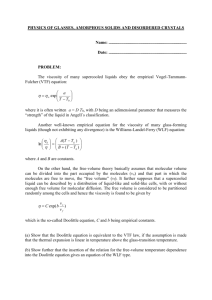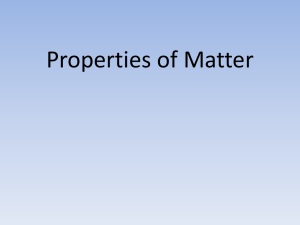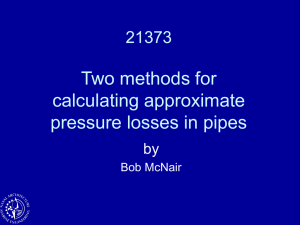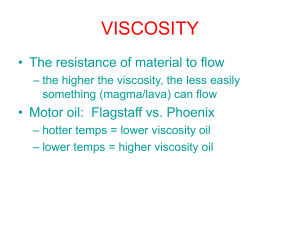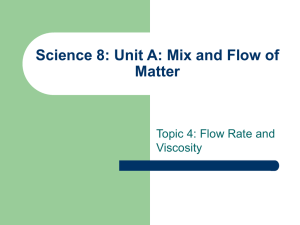UN/SCEGHS/19/INF
advertisement
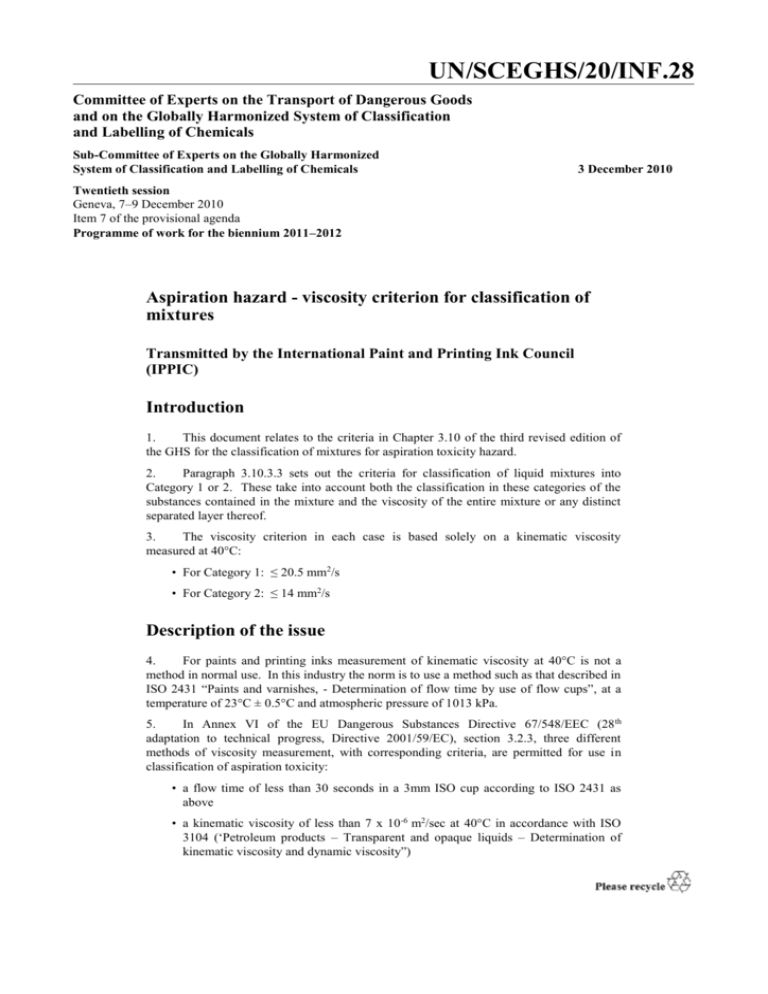
UN/SCEGHS/20/INF.28 Committee of Experts on the Transport of Dangerous Goods and on the Globally Harmonized System of Classification and Labelling of Chemicals Sub-Committee of Experts on the Globally Harmonized System of Classification and Labelling of Chemicals 3 December 2010 Twentieth session Geneva, 7–9 December 2010 Item 7 of the provisional agenda Programme of work for the biennium 2011–2012 Aspiration hazard - viscosity criterion for classification of mixtures Transmitted by the International Paint and Printing Ink Council (IPPIC) Introduction 1. This document relates to the criteria in Chapter 3.10 of the third revised edition of the GHS for the classification of mixtures for aspiration toxicity hazard. 2. Paragraph 3.10.3.3 sets out the criteria for classification of liquid mixtures into Category 1 or 2. These take into account both the classification in these categories of the substances contained in the mixture and the viscosity of the entire mixture or any distinct separated layer thereof. 3. The viscosity criterion in each case is based solely on a kinematic viscosity measured at 40°C: • For Category 1: ≤ 20.5 mm2/s • For Category 2: ≤ 14 mm2/s Description of the issue 4. For paints and printing inks measurement of kinematic viscosity at 40°C is not a method in normal use. In this industry the norm is to use a method such as that described in ISO 2431 “Paints and varnishes, - Determination of flow time by use of flow cups”, at a temperature of 23°C ± 0.5°C and atmospheric pressure of 1013 kPa. 5. In Annex VI of the EU Dangerous Substances Directive 67/548/EEC (28 th adaptation to technical progress, Directive 2001/59/EC), section 3.2.3, three different methods of viscosity measurement, with corresponding criteria, are permitted for use in classification of aspiration toxicity: • a flow time of less than 30 seconds in a 3mm ISO cup according to ISO 2431 as above • a kinematic viscosity of less than 7 x 10 -6 m2/sec at 40°C in accordance with ISO 3104 (‘Petroleum products – Transparent and opaque liquids – Determination of kinematic viscosity and dynamic viscosity”) UN/SCEGHS/20/INF.28 • a kinematic viscosity of less than 7 x 10 -6 m2/sec at 40°C in accordance with ISO 3219 (‘Plastics – Polymers/resins in the liquid state or as emulsions or dispersions – Determination of viscosity using a rotational viscometer with defined shear rate’). The same methods are also referenced in the Australian Approved Criteria. 6. The UN Manual of Tests and Criteria, 4th revised edition, paragraph 32.4.3 also mentions ISO 2431 as one of the methods for measurement of the viscosity of flammable liquids when used to determine the Packing Group (and to exclude high viscosity products) in the Model Regulations on the Transport of Dangerous Goods, 16th revised edition, paragraph 2.3.2, and in modal regulations (e.g. ADR, paragraph 2.2.3.1.5). This however refers to the ISO standard cup with a 4mm jet rather than 3mm as in the EU directive mentioned above. 7. Paragraph 3.10.1.6.3 of GHS provides a formula for conversion between dynamic and kinematic viscosity (under equivalent conditions). For ISO cups empirically-derived formulae also exist permitting calculation of the kinematic viscosity from the flow time, but again under equivalent conditions. There is no simple equation permitting extrapolation of a kinematic viscosity criterion at 40°C to one measured at 23°C; the viscosity-temperature relationship must normally be derived by tests and calculation of the flow activation energy. 8. Measurement of viscosity at 40°C requires a casing for temperature control and is not current practice in the paint and printing ink industry. This was the reason for the introduction into Directive 67/48/EEC of a viscosity criterion in accordance with ISO 2431. The latter criterion cannot however simply be adopted directly in the GHS, since the corresponding criterion values for kinematic viscosity at 40°C given in 67/548/EEC are different from those in the GHS. The definition of a substance or mixture constituting an aspiration toxicity hazard according to GHS is therefore not the same as that in the aforementioned EU directive. Proposal 9. In order to facilitate proper classification of substances and mixtures for aspiration toxicity hazard, test methods and criteria values should be included in the GHS which are compatible with practices in those industries where there is a need to classify. 10. Paragraph 3.10.3.3 should be amended to include an appropriate criterion for viscosity determined at 23°C, thus enabling paint and printing ink manufacturers to classify in this hazard class without the change to worldwide industry practice which would otherwise be required, with associated costs. A consequential change to the UN Manual of Tests and Criteria may be required, depending upon the solution identified. 11. Since no simple solution for this issue is readily available at this time, the SubCommittee is requested to consider its inclusion in the work programme for the 20112012 biennium. IPPIC is willing to participate in the development of a proposal for amendment of the GHS, but also welcomes input from other experts and/or industry delegations. 2

